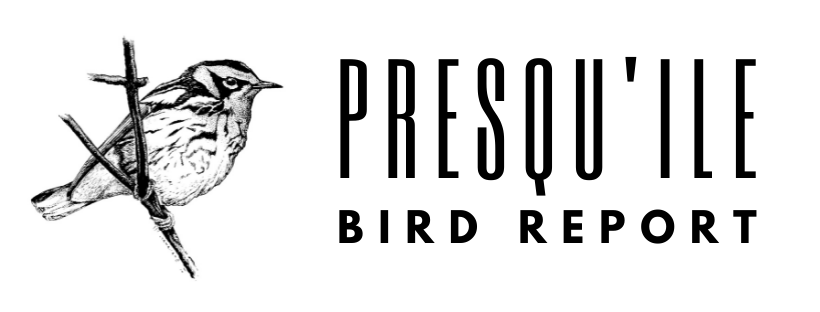
Over 100 species of birds have been seen at Presqu'ile Provincial Park in the past week, a clear indication that the fall migration is in full swing. The rarer shorebirds that have finally arrived have attracted a steady stream of birders, most of whom are also finding a variety of passerine birds.
A few WOOD DUCKS have consistently been in the extreme south-west corner of the marsh. Two NORTHERN SHOVELERS were off Gull Island on August 28. A surprisingly large flock (over 100 by one count) of WHITE-WINGED SCOTERS has been far offshore in Popham Bay, visible only with good optical equipment and in favourable viewing conditions. Also far out in Popham Bay are up to seven HORNED GREBES and up to fourteen RED-NECKED GREBES. In the family Ardeidae, the following five species have been seen: AMERICAN BITTERN, GREAT BLUE HERON, GREAT EGRET, GREEN HERON, BLACK-CROWNED NIGHT-HERON. Single BROAD-WINGED HAWKS on Tuesday and Wednesday were early migrants.
This week Presqu'ile has reclaimed its reputation as a shorebird hot spot. They have been easy to observe along the beach south from beach 2, whenever passing falcons leave them alone. Thirteen species have been observed in the past week, with at least half a dozen more expected to arrive soon. Two species, BLACK-BELLIED PLOVER and STILT SANDPIPER were seen only once, the latter before it flew off, never to be re-located. In contrast, many observers have been able to identify difficult species (WHITE-RUMPED and BAIRD'S SANDPIPERS) as well as at least one PECTORAL SANDPIPER. The main attraction has been BUFF-BREASTED SANDPIPERS, first seen (one only) on August 29, and increasing to two on the next day and three thereafter until September 3. The composition of the shorebird flocks has remained fairly stable all week. Once the weather pattern changes, more numbers and other species, perhaps including WESTERN SANDPIPER, may be expected, but observers are cautioned not to jump to conclusions about that notoriously difficult species. Up to four GREAT BLACK-BACKED GULLS have also been on the beach.
A ROCK PIGEON, uncommon at Presqu'ile, was seen on Monday. Nocturnal and crepuscular birding has revealed the presence of BARRED OWL, varying numbers of COMMON NIGHTHAWKS (12 on August 28, 10 on August 29, 7 on August 30), and an EASTERN WHIP-POOR-WILL. A CHIMNEY SWIFT on August 29 was the first in several months. Among woodpeckers were two RED-BELLIED and four PILEATED WOODPECKERS. Three species of falcons in the past week were MERLINS (two chasing shorebirds), AMERICAN KESTREL, and PEREGINE FALCON (flying past Owen Point on Friday). An OLIVE-SIDED FLYCATCHER on August 31 and a YELLOW-BELLIED FLYCATCHER on August 29 were noteworthy. PHILADELPHIA VIREOS were seen on August 28 and September 1. There were at least three COMMON RAVEN sightings. Two PURPLE MARTINS on August 28 were rather late. A photograph of a CAROLINA WREN taken in the Park on August 15 has only recently come to my attention, but that bird may still be in the Park. Both VEERY and SWAINSON'S THRUSH were among the migrants present this week. A TENNESSEE WARBLER was seen on two different days and CAPE MAY WARBLERS almost every day. The first BLACKPOLL WARBLER was found yesterday, bringing the total number of warbler species to twenty for the past week. SCARLET TANAGERS and ROSE-BREASTED GROSBEAKS have also been moving through. Three BOBOLINKS flew over on August 29.
To reach Presqu'ile Provincial Park, follow the signs from Brighton.
Locations within the Park are shown on a map at the back of a tabloid that is available at the Park gate. Access to the offshore islands is restricted from March 10 onward to prevent disturbance to the colonial nesting birds there.
Birders are encouraged to record their observations on the bird sightings board provided near the campground office by The Friends of Presqu'ile Park and to fill out a rare bird report for species not listed there.
Questions and comments about bird sightings at Presqu'ile may be directed to: FHELLEINER@TRENTU.CA.


